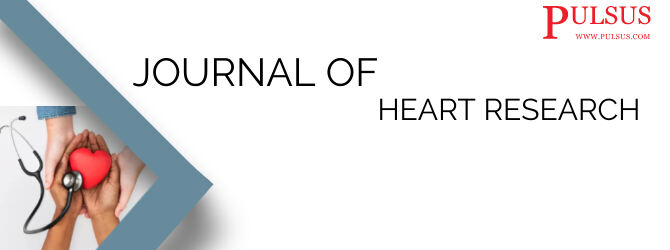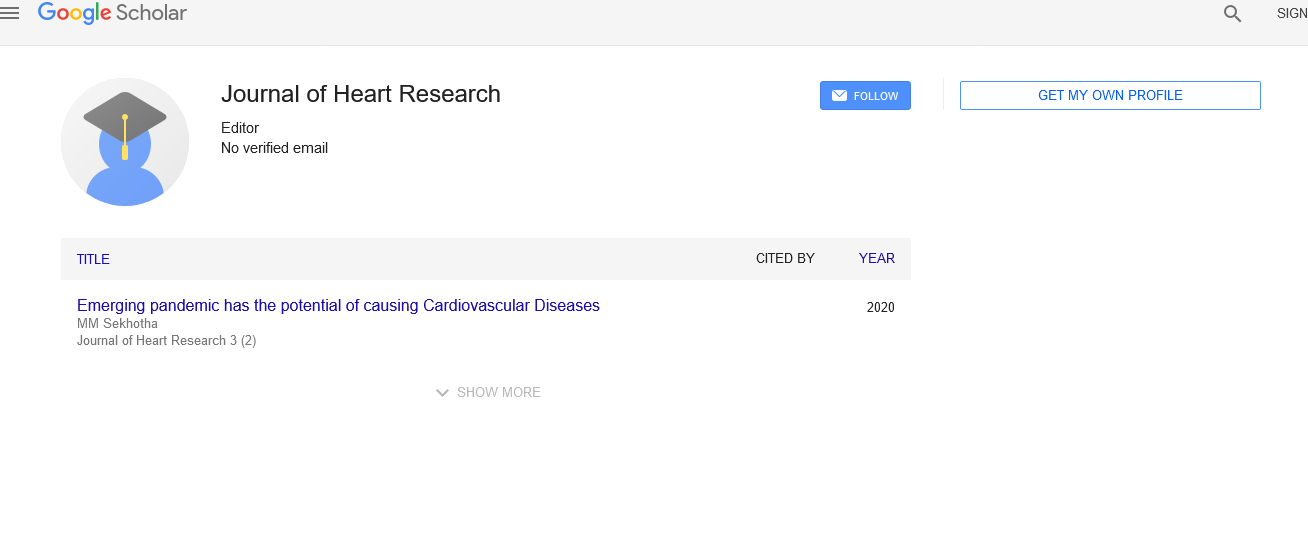Benefits and drawbacks of telecardiology
Received: 26-Jul-2022, Manuscript No. puljhr-22-5273; Editor assigned: 30-Jul-2022, Pre QC No. puljhr-22-5273(PQ); Accepted Date: Aug 22, 2022; Reviewed: 13-Aug-2022 QC No. puljhr-22-5273(Q); Revised: 20-Aug-2022, Manuscript No. puljhr-22-5273(R); Published: 27-Aug-2022, DOI: 10.37532/ puljhr.2022. 5(4).01-03.
Citation: John A. Benefits and drawbacks of telecardiology. Int J Heart Res. 2022; 5(4):1-2.
This open-access article is distributed under the terms of the Creative Commons Attribution Non-Commercial License (CC BY-NC) (http://creativecommons.org/licenses/by-nc/4.0/), which permits reuse, distribution and reproduction of the article, provided that the original work is properly cited and the reuse is restricted to noncommercial purposes. For commercial reuse, contact reprints@pulsus.com
Abstract
Telecardiology is one of several health information technology applications that have historically presented a number of difficulties. Succession adoption of these strategies might result from recognizing these issues and making a strategy to deal with them. The objective of this investigation was a list of telecardiology's benefits and drawbacks, as well as information on both using the outcomes, provide strategies for its effective implementation.
Modern medicine employs telecardiology to diagnose and treat heart problems at a distance using the power of telecommunications. This covers arrhythmias, congestive cardiac failure, abrupt cardiac arrest, and both chronic and acute coronary heart disease. In this instance, doctors and other healthcare professionals use electrocardiographic data that is remotely relayed in real-time for expert interpretation. People who live in rural areas can now obtain specialized care. In order to accomplish this, wireless or satellite networks may now be set up more easily and affordably thanks to advances in technology. It is advised that telecardiology systems be utilized more frequently to deliver healthcare services to remote and rural locations as well as those lacking specialists. Preliminary research is necessary due to the difficulties in successfully implementing telecardiology, including feasibility studies, acceptability studies, and first pre-implementation assessments.
The benefits of telecardiology were broken down into eight major categories: streamlining the delivery of healthcare, improving medical education, and healthcare quality, raising HCP performance, cutting costs, making healthcare services available and accessible, managing data, and monitoring patients. In addition, the obstacles to implementing telecardiology were broken down into six categories: the nature of the cardiac illness, human resources, difficulty with Information Technology (IT), issues with wearable technology, and ambiguity of outcomes.
Key Words
Telemedicine, Cardiology, Cardiovascular Disease
Introduction
One of the leading causes of mortality globally is heart disease. Access to healthcare services at all levels, especially in distant places, can lower the death rate among people with cardiac disorders. However, the health system has major difficulties in delivering cardiac treatment to individuals in distant locations without access to experts. Healthcare professionals and management are thinking about leveraging information technology to deliver high-quality and timely healthcare services to patients with cardiovascular disease due to the high sensitivity of these services [1]. By raising the clinician's degree of primary knowledge, telecardiology also enhances the practical training of the typical practitioner. This therapeutic strategy enables to delivery of superior care. The diagnosis and treatment of pediatric heart disease, chronic cardiac failure, and unexpected cardiac events like myocardial infarctions all fall under this umbrella [2]. Additionally, telecardiology can reduce consultation times to a quarter while still providing patients with top-notch treatment when it is most required. The amount of time that passes between patients being admitted to the hospital and needing to have angioplasty, or door-to-balloon time, when telecardiology is available has also been demonstrated to be significantly reduced [3]. With the use of telecardiology, the correct diagnosis can be made, the necessary staff can be ready for the patient even before admission, surgery can be performed faster and muscle damage can be stopped in its tracks [4]. The use of telemedicine has been shown to make it easier to provide medical care in remote locations and to advance health equity. Telemedicine, according to the World Health Organization (WHO), is the practice of providing healthcare services by professionals via transmitting knowledge about the diagnosis, prevention, and treatment of illnesses and other health issues. In reality, telemedicine is a helpful tool for delivering a variety of health treatments based on information technology advancements.
FEATURES OF THE INCLUDED STUDIES
Sometimes, a patient's life can be saved by promptly delivering an Electro Cardiography (ECG) result to a cardiologist and initiating the required early treatment based on the ECG interpretation. By relying on telecardiology's fundamental capabilities, this will be achievable. The ability to do ECG utilizing newly developed instruments, like smartwatches or implanted devices in the patient's body, is also available at higher levels of telecardiology. Additionally, some technologies, like the Global Positioning System (GPS), can transmit these findings to the pertinent facilities so that patients can receive the right medical care. Additionally, this technology may be utilized to educate nascent doctors and get specialized advice from healthcare professionals [5]. Along with making it easier to provide specialized healthcare services and enhancing in situations when there are few amenities and no hospital, for example, telecardiology can offer patients the appropriate specialist treatments they need at a cardiac center with a focus on remote locations. Up to several thousand dollars in savings. The purpose of the current study is to evaluate the advantages and difficulties of employing telecardiology to treat patients with cardiovascular disease. The study's findings can serve as a useful manual for managers and policymakers by outlining the advantages and difficulties of telecardiology deployment and offering solutions [6].
In the regions where it is used, teleconsultation in cardiology is proven to be an excellent technique that can enhance communication between primary care physicians and cardiac experts. In the long run, it also has a non-negligible educational value and strengthens professional connections. Although telemedicine has been around for a while, it is still not well used. Excellent prospects are provided by telecardiology. It promotes patient-physician collaboration and communication and enables patients to play a more active part in the healthcare system. Every bit of data might potentially be used intelligently.
Devices for telecardiology may be quickly brought to the patient's bedside to provide a speedier and more precise diagnostic because they are lightweight and portable. It has been demonstrated that telecardiology may boost the effectiveness and cost-efficiency of healthcare while also saving lives. In conclusion, telecardiology facilitates faster and more convenient detection of acute coronary events, improves patient access to specialized treatment, provides improved patient triage and management, and lessens the pressure on secondary referral hospitals [7].
They examined the efficacy of using electronic consultation to strengthen the bond between cardiology and primary care in places where access to healthcare is problematic. Nearly half of the referrals to cardiology in this study did not require a face-to-face visit, and roughly half of all referrals to cardiology met the study criteria to be sent through electronic consultations. Additionally, electronic consultation reviews were completed, on average, almost a month before those sent for face-to-face consultations, even those considered urgent by the sending physician. With these facts, the authors claimed that teleconsultation benefits patients and does not put them in danger. In the regions where it is used, teleconsultation in cardiology is proven to be an excellent technique that can enhance communication between primary care physicians and cardiac experts. In the long run, it also has a non-negligible educational value and strengthens professional connections [8].
Discussion
According to the study's findings, telecardiology devices should be used used more often to deliver healthcare in remote and rural locations as well as to people who lack access to experts. Preliminary studies including feasibility studies, acceptability studies, and first preimplementation assessments are necessary given the difficulties in successfully implementing telecardiology. Authorities should focus on providing sustainable financial resources to deliver these services to address the financial challenges related to the installation and continued use of telecardiology. Because certain research has highlighted the need for further studies on the impact of telecardiology on the process of delivering healthcare services, additional studies on the deployment, usage, and assessment of telecardiology systems are also recommended. One of the most recent developments in the field of telecardiology is the integration of information technology-based services with advancements in artificial intelligence. These services might simplify and lower the cost of telecardiology. Therefore, it is advised that additional research be done in this area.
REFERENCES
- Tsagkaris C, Matiashova L, Papazoglou AS,et al. Telecardiology in the Era of COVID-19: Slaying the Lernaen Hydra of Cardiovascular Disease with the Assistance of a Post-modern Iolaus. Indo Glob. J. Pharm Sci. 2022;12:110-4.
- Yew HT, Chekima A, Kiring A, et al. RSS Based Vertical Handover Schemes in Heterogeneous Wireless Networks: Past, Present & Future. In2020 IEEE 2nd Int. Conf. Artif Intell Eng Technol. 2020;1-5.
- Blinkhorn TM et al. Telehealth in nephrology health care: a review. Ren. Soc. Australas J. 2012;8(3).
[Google Scholar] [Cross Ref]
- Marcolino MS, Alkmim MB, Pessoa CG, et al. Development and implementation of a methodology for quality assessment of asynchronous teleconsultations. Telemed. e-Health. 2020;26(5):651-8.
- Woldaregay AZ, Walderhaug S, Hartvigsen G. et al. Telemedicine services for the arctic: a systematic review. JMIR med. inform. 2017;5(2):e6323.
- Bailo P, Gibelli F, Blandino A, et al. Telemedicine applications in the era of COVID-19: telesurgery issues. Int. J. Environ Res Public Health. 2021;19(1):323.
- Fensli R, Oleshchuk VA, O'Donoghue J, et al. Design requirements for a patient administered personal electronic health record. InTech; 2011.
[Google Scholar] [Cross Ref]
- Balasingam M, Ebrahim J, Ariffin IA, et al. Tele-echocardiography–Made for astronauts, now in hospitals. Indian heart j. 2017;69(2):252-4.





